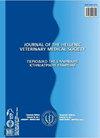牛与水牛异物综合征氧化应激指标的比较研究
IF 0.4
4区 农林科学
Q4 VETERINARY SCIENCES
引用次数: 0
摘要
本研究比较了异体综合征(FBS)牛和水牛的氧化应激指标。这项研究包括60只动物(32只水牛和28头奶牛)。将动物分为对照组(10头健康奶牛和10头健康水牛)。根据临床表现、病程及x线、超声检查结果将患病动物分为慢性外伤性网状腹膜炎(TRP)组(13头牛、12头水牛)、急性TRP组(5头水牛)和外伤性心包炎(TP)组(5头牛、5头水牛)。获得完整的病例史,并进行彻底的临床检查。采集血样进行血液学和生化分析。各患病动物组丙二醛(MDA)水平和超氧化物歧化酶(SOD)活性均高于对照组,还原性谷胱甘肽(GSH)活性显著低于对照组。慢性TRP组谷胱甘肽过氧化物酶(GSH-PX)活性显著升高,水牛慢性TRP组谷胱甘肽过氧化物酶活性显著降低,急性TRP组和TP组变化不显著。过氧化氢酶活性仅在施TP的水牛中增加。慢性TRP奶牛和急性TRP水牛的总抗氧化能力显著提高,表明氧化应激具有代偿性抗氧化机制。急性和慢性TRP和TP的牛和水牛在氧化应激条件下均表现出抗氧化能力。牛和水牛对氧化损伤的反应有显著差异,慢性TRP的水牛表现出抗氧化能力失代偿,导致慢性损伤和纤维化。本文章由计算机程序翻译,如有差异,请以英文原文为准。
A comparative study on oxidative stress indices among cattle and buffalo with foreign body syndrome
This study compared the oxidative stress indices in cattle and buffalo with foreign body syndrome (FBS). The study included 60 animals (32 buffalo and 28 cows). The animals were divided into the control group (10 healthy cows and 10 healthy buffalo). The diseased animals were divided based on the clinical signs and duration of illness as well as radiographic and ultrasonographic findings into the chronic traumatic reticuloperitonitis (TRP) group (13 cows and 12 buffalo), acute TRP group (5 buffalo), and traumatic pericarditis (TP) group (5 cows, 5 buffalo). Full case histories were obtained, and thorough clinical examinations were performed. Blood samples were obtained for hematological and biochemical analysis. The malondialdehyde (MDA) level and superoxide dismutase (SOD) activity increased in all diseased animals’ groups, while the reduced glutathione (GSH) activity significantly decreased in all diseased animals’ groups than in the control group. The glutathione peroxidase (GSH-PX) activity increased dramatically in cows with chronic TRP and significantly decreased in buffalo with chronic TRP and not significantly changed in the groups with acute TRP and TP. The catalase activity only increased in buffalo with TP. The total antioxidant capacity increased significantly in cows with chronic TRP and buffalo with acute TRP, indicating oxidative stress with the compensated antioxidant mechanism. Finally, both cattle and buffalo with acute and chronic TRP and TP showed an existing antioxidant capacity despite oxidative stress. There was a significant difference between cattle and buffalo in their response to oxidative damage, in which buffalo with chronic TRP showed a decompensation of the antioxidant capacity leading to chronic damage and fibrosis.
求助全文
通过发布文献求助,成功后即可免费获取论文全文。
去求助
来源期刊

Journal of the Hellenic Veterinary Medical Society
VETERINARY SCIENCES-
CiteScore
0.60
自引率
0.00%
发文量
83
审稿时长
>12 weeks
期刊介绍:
The Journal of the Hellenic Veterinary Medical Society (J Hellenic Vet Med Soc) is a quarterly peer-reviewed journal that publishes articles in all aspects of veterinary science and related disciplines. It is published by the Hellenic Veterinary Medical Society and is indexed in the Web of Science and in Scopus.
There are no publication fees in the journal. Authors considering submitting manuscripts for evaluation and publication are requested to read carefully the instructions for authors and fully comply with them.
Non-complying manuscripts may be returned to the corresponding author for formatting.
 求助内容:
求助内容: 应助结果提醒方式:
应助结果提醒方式:


